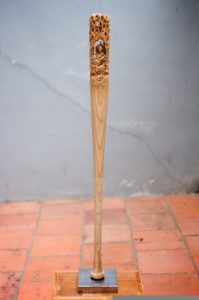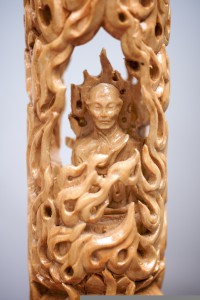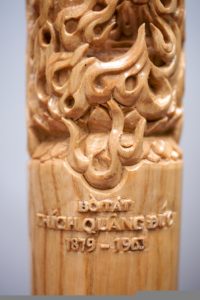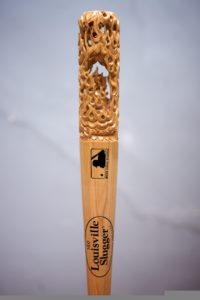2009
Carved wooden baseball bat [Louisville Slugger, Northern White Ash, Chromed metal base plate
87cm x 6.5cm [diameter]; base 12cm x 12cm x 2.5cm
In Tuan Andrew Nguyen’s Enemy’s Enemy: Monument to a Monument (2012), a classic American Louisville Slugger baseball bat is transformed into a meditation on the unifying and divisive powers of religion and sport. The figure carved into the bat is a memorial to Thích Quảng Đức, a highly venerated Buddhist monk who in 1963 performed self-immolation in protest against the repression of the Buddhist community by Ngô Đình Diệm’s South Vietnamese government. An official bias toward Roman Catholicism, a remnant of the region’s French colonization, led, in the post-Cochinchina period after 1954, to religious inequality, prompting Thích Quảng Đức’s demonstration. The selfless act was widely televised, and formed part of the mounting pressure on the Diệm government that led to its deposition later in the year. Popular sports such as baseball can also stir community loyalties, uniting and dividing groups as do organized religions. Enemy’s Enemy illustrates the contradiction embodied by the two phenomena, their shared power to both engender solidarity and instigate conflict. In addition, the commemorative monument, installed in a reunited Vietnam, appears highly incongruous given the communist state ideology’s antipathy toward religion.
Layered over the work’s reference to a specific moment in Vietnamese history is an allusion to the Vietnam War as a whole, and to the U.S. support that the South Vietnamese received during that conflict. The patented bat is manufactured by Hillerich & Bradsby, a company that in the 1940s produced rifle stocks for the U.S. army as part of the war effort. Given this history, and through the image of the flames eating through the bat’s critical section, a sense of violence pervades the work. Yet the figure of the bodhisattva—a name bestowed in acknowledgement of Thích Quảng Đức’s enlightened status—emanates serenity and acquiescence (the monk’s self-sacrifice was performed in silence).
In Enemy’s Enemy, the historical Vietnamese craft of woodcarving is brought to contemporary life. This skill, used in architectural detailing and figurative representation, was promoted by the last Vietnamese dynasty, the lineage of Nguyễn (1802–1945). In Enemy’s Enemy the cultural exchange is reciprocated in a commemorative transformation of the American Northern White Ash baseball bat. Thus the work demonstrates the artist’s aptitude for marrying seemingly disparate subjects and materials, reflecting diverse cultural influences from East and West, and incorporating popular-cultural elements. (June Yap, Solomon R. Guggenheim Museum)





